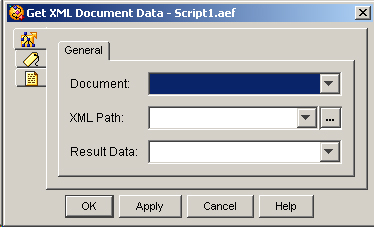Get XML Document Data Step
Use the Get XML Document Data step after the Create XML Document step to obtain data from a document formatted with XML.

Note | You can use the Get XML Document Data step only on a document that was returned by the Create XML Document step. If you attempt to use it on any other type of document, errors will occur. |
<?xml version="1.0" standalone="yes"?>
<STOCKLIST>
<STOCK symbol="MSFT" error="0">
<HIGH>58.0625</HIGH>
<PCT_CHANGE>0.67114094</PCT_CHANGE>
<LOW>55.1875</LOW>
<LAST>56.25</LAST>
<CHANGE>0.375</CHANGE>
<VOLUME>31,973,600</VOLUME>
<REC_STATUS>0</REC_STATUS>
<DATE>02/21/2001</DATE>
<TIME>15:52</TIME>
</STOCK>
</STOCKLIST>To extract data from an XML file, you must identify the exact XML path, as in the example below:
/descendant::STOCKLIST
/child::STOCK[attribute::symbol='CSCO']
/child::LASTThe XML path is composed of location steps separated by a forward slash (/). In the example above, the XML path has three location steps. Each location step is composed of three parts:
-
Axis—Relation to the context (for example, descendant or child).
-
Node test—Field name (for example, STOCK).
-
Predicates (optional)—Properties and values within a field (for example, [attribute::symbol='CSCO']).
Note | You must execute a separate Get XML Document Data step for each field in the XML file that you want to use. |
The fallowing table describes the properties of the Get XML Document Data customizer window.
|
Property |
Description |
|---|---|
|
Document |
Document variable created as the Result Document in a preceding Create XML Document step. |
|
XML Path |
XML path that defines a specific field or value in an XML document. |
|
Result Data |
Document variable that contains the XML data. |
To use the Get XML Document Data customizer window to specify a document variable that will contain XML data, do the following procedure:
Procedure
| Command or Action | Purpose | |||
|---|---|---|---|---|
| Step 1 | From the Document drop-down menu, choose the variable that stores the source document. | |||
| Step 2 | In the XML Path field, enter a value directly or take one of the following actions: |
| ||
| Step 3 | From the Result Data drop-down menu, choose the variable that stores the resulting XML document. |
| ||
| Step 4 | Click OK. | The Get XML Document Data customizer window closes, and the names of the Result Data, Document, and XML Path variables appear next to the Get XML Document Data step icon in the Design pane of the Cisco Unified CCX Editor. |